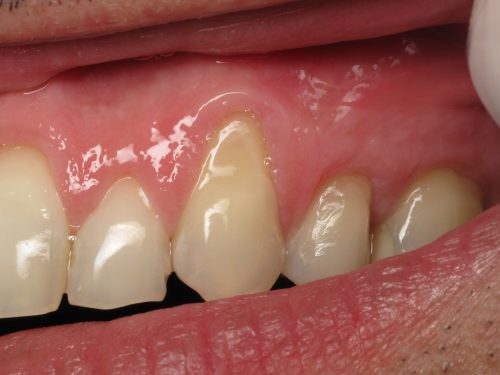Gum recession is the moving of gum edge (gingiva) toward the root. Gum recession can affect all or nearly all teeth (general gum recession) , or it can affect only some teeth. Can be of different size and shape.
The beginning stage of periodontitis is gum inflammation (gums are red, swollen, bleeding) after which comes gum decay and tissue is stripped from the root. This makes teeth look longer. That is the advanced stage of periodontitis and by now all or most teeth have receding gums. Gum recession does not only mean the loss of soft tissue but also signifies the loss of bone tissue. In time bone tissue is damaged to that extent that it causes the tooth to get loose and eventually lost. This is the terminal stage of periodontitis. Now we know that gingival recession does not only happen from the outer side but affects all the tissue around the tooth. Scale is formed due to mineral accumulation in soft tooth layers (dental plaque) . This is the basic reason of receding gums and loss of bone tissue.
Gum recession that is manifested on one, or a few teeth is characterised by exposing the root on the outer side.
One of the causes of gum recession can be occlusal trauma. This dental term refers to a situation where during the closing of jaw some od the teeth come into contact with food, or something else, before other teeth and those teeth are overloaded (traumatized) . It is then that gums and bone tissue are damaged. There are two reasons for teeth early contact. The first is tooth loss that is followed by tooth movement. The other problem are orthodontic tooth anomalies. Because teeth have a wrong layout the distribution of load is unequal too.
Bad brushing technique can also be a reason for receding gums. Agressive brushing sould be avoided (more pressure than needed, hard brush, horizontal brush movement) because it could contribute to gum recession. Also, bad dentures or fillings can cause gum recession.Because of these reasons you shouldn’t allow anyone to take care of your teeth.
Gum recession treatment
How to treat gum recession? There is no universal cure for it. Causes are what needs to be removed in order for the gums ro recover. Depending on the cause you should do the following:
-Reduce some teeth to remove traumatic contact
-Correct an irregular tooth position by orthodontic therapy
-Replace bad prosthetics
-Surgically correct high frenulum
-Maintain regular oral hygiene
-Prosthetic rehabilitation
All about periodontology
GUM DISEASES
Gum diseases are becoming more and more frequent and it is estimated that 80% of adult people suffer from some sort of gum disease. These diseases are very unpleasant.What causes gum diseases?
GINGIVITIS SYMPTOMS
Symptoms are very hard to notice because is considered a “quiet” disease but it is not rare that it ends with teeth loss. This disease advances slowly but has almost no symptoms.
GUM RECESSION
Gum recession is the moving of gum edge (gingiva) toward the root. Gum recession can affect all or nearly all teeth (general gum recession) , or it can affect only some teeth. Can be of different size and shape.
FLAP SURGERY
Flap surgery has proven to be the best method for resolving periodontitis. Periodontitis is a disease of the supporting structures of the teeth, meaning the connection between the tooth root and the bone.
PERIODONTITIS
Periodontitis is an advanced chronic inflammation of the gums. It is one of the most common diseases overall. The presence of bacteria in dental plaque leads to the development of inflammation that affects the supporting structures of the teeth located around the tooth root …
GUMMY SMILE
Visible gums while smiling is a relatively frequent phenomenon.Such people avoid laughing and feel uncomfortably in company. They consider it an aesthetic imprefection.
Didn’t find the right answer?
Send an inquiry to our staff and we will send you an answer as soon as possible.



